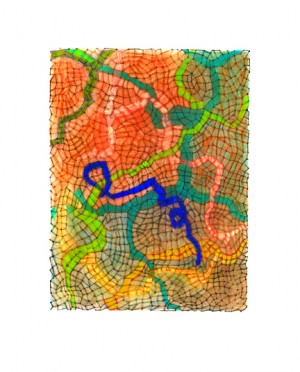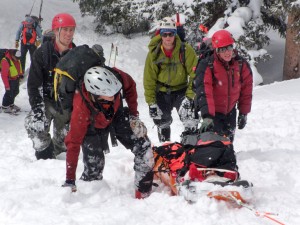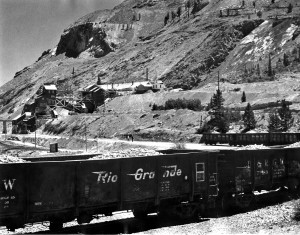by Hal Walter
It pays to be “in the now” in my line of work, but often I find my mind somewhere else and running on overdrive as I go about my chores.
My most reliable employment these days is managing a small ranch where we keep horses, cattle and a fair number of barn cats. There’s a big barn at the ranch and in one corner is an enclosed tack room. When I first started this job five years ago the tack room was overrun with mice. And when trapping them became tedious, I finally opted for some mostly feral cats.
This worked great, but with barn cats you need cat food (I buy it by the 50-pound bag), and with cat food you can attract other critters.
When I show up for my chores in the morning the cats generally scatter in all directions. There are a couple that are approachable, but I’m quite accustomed to seeing cats run or scurry away slowly when I arrive. One morning early in March I was headed for the tack room to get feed for the horses when I noticed out of the corner of my eye a cat slinking behind the tractor about 10 feet away. I proceeded to the tack room, opened the old freezer where we store the feed. Maybe the coffee was weak that morning, but I had scooped about three servings into the bucket when it finally registered that the cat by the tractor sure seemed a mite bit larger than our barn cats.
And, come to think of it, it had black spots, too.
I walked slowly back out the tack room door with the bucket in hand and a strange low growl emanated from behind the tractor. I headed out the front door in a hurry.
There’s a gate on the far east end of the building so I headed around there for a safer vantage. Sure enough, from about 30 feet away I could see that our newest barn cat was apparently a bobcat, though its ears looked smaller, its build was more slender and it was whiter than most bobcats I’ve seen. Perhaps it was a youngster. It paced back and forth behind the tractor. Then it slipped into the workshop across from the tack room, turned around and stood with its neck out, staring back at me.
I thought about this for a moment then decided to drive to the house and get my camera. When I returned I first checked the perimeter of the barn for tracks in the fresh snow. There were no bobcat prints to be found, so I figured it was still inside.
With my camera in hand, I carefully searched out the barn for the suspected bobcat, all the while being mindful not to corner it in some hiding spot. I never located the creature, though there are a few potential hiding spots that I could not safely search out.
Sadly, what I did find were half-eaten remains of one of our barn cats. It had been covered with hay, in the style of wild felines. I left the dead cat there so I could tell if the bobcat returned. I didn’t see any of the other barn cats around. The next morning, however, the half-eaten cat carcass had been picked clean. Also, all of the cat food I leave out for the cats had been eaten.
For several days the barn remained eerily free of cats. And the cat food dish remained full. One morning I climbed into the loft and saw one of the barn cats peering out at me from a crevasse in the rafters.
As the weeks went by a few of the cats returned, and I noticed that the cat food was again being eaten. There were obviously fewer cats, and I figured some had been eaten by the bobcat and others had scattered to the four winds. Things were halfway back to normal.
Then one day recently I walked into the barn tack room and found the old chest freezer completely tipped over, and the entire tack room in disarray. Not too hard to figure out a bear had gotten in there overnight. I picked things up and turned the freezer back over. Mostly the bear had eaten cat food. I called Justin Krall, our local Division of Wildlife officer, and we discussed what to do. He suspected the bear to be an old sow that he once caught in an old bus near here. The bear had found grain stored in the bus.
He tranquilized the bear, pulled it out of the bus and drove it up near Black Mountain, where he released her. This was more than 50 miles north as the crow flies, or as the bear wanders. Within two years the bear had made her way back. She was ear-tagged, numbered, and all out of chances.
The tack-room door is a double, over-under deal. I usually keep the top open for air flow, and the bottom loosely closed with a chain so the cats can move in and out. The bear had no trouble getting through this arrangement.
That night I bolted the door shut, top and bottom, and the next morning found the bear had unlocked the bolt and ransacked the tack room once again.
The general feeling is that this bear is so old it can’t get enough calories by foraging. At some point she became habituated to burgling high-energy livestock and pet foods from sheds and barns. Our other wildlife officer Zach Holder, removed her from a neighbor’s barn last summer. He told me he thought the sow would die in her den over the winter. Ironically it was probably a diet of horse grain that pulled her through. And she seemed to come out of hibernation even hungrier than before. Other neighbors also had been having problems with a bear getting into sheds and barns.
I called Justin and he came by with an “unwelcome mat” to place in front of the door. Essentially the mat is a piece of plywood with screws sticking up through it to make it uncomfortable for the bear to step on. I also removed all cat food from the premises, and improved the door-bolt seat. And for about a week I thought we had solved the problem.
Then one day I found the tack room door had been destroyed, and the freezer tipped over again. Pretty brazen stuff. This time the bear had eaten horse feed and some powdered milk replacement I had bought for a sick calf a year ago. I cleaned up the mess and removed all feed items from the tack room. Then I made some calls.
It’s a difficult thing to play God with an old bear. She’s already coming inside a building, breaking down doors and entering rooms. Who knows when she might decide to break into a house. After talking it over with the ranch owners and DOW officers, we all agreed it’s time for this sow to move on.
The most difficult thing is making the decision. After that, it’s just a matter of setting a trap and waiting. Unfortunately when people share the ecosystem with animals it doesn’t always end well. This sort of thing can make a thinking person question just where to draw the line, and also our existence here in the mountains.
This morning I fixed several woodpecker holes in my outbuildings, and installed a fake owl. And I opened a window in the garage so a hummingbird could escape. So it goes.
Hal Walter writes and edits from the Wet Mountains. You can keep up with him regularly at his blog: www.hardscrabbletimes.com


